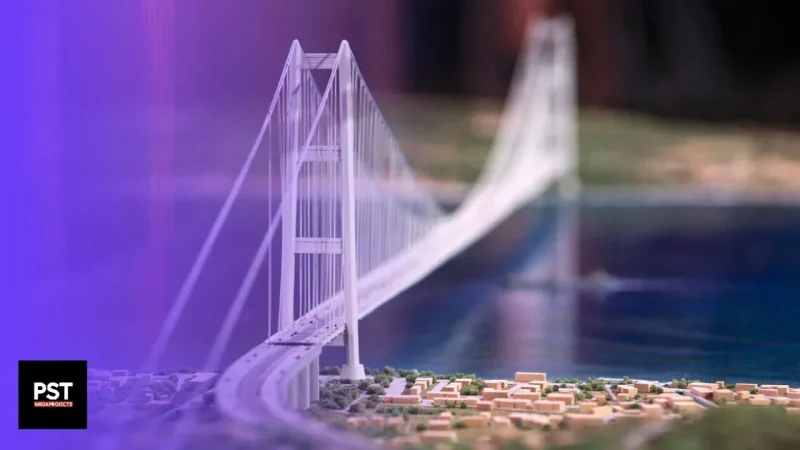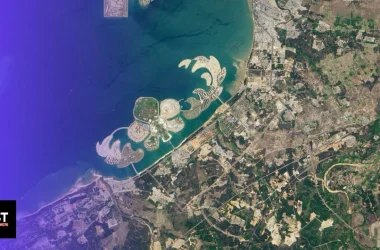Italy is currently gearing up for an extremely ambitious megaproject that will capture the world’s attention – the construction of the world’s longest suspension bridge. Spanning 3.2 kilometers across the Strait of Messina, this bridge aims to connect Italy’s mainland directly to the stunning island of Sicily.
Once completed, the $12.4 billion Strait of Messina Bridge will easily snatch the title of the longest suspension bridge in the world from Turkey’s Çanakkale Bridge, triumphantly stretching over a kilometer longer.
With a history dating back to Roman times, this bridge has been thousands of years in the making, but it’s still seeing its fair share of challenges, from the strong water currents in the strait, to political risks and being threatened by the Italian Mafia.
Why is Italy Building it?
The division between Sicily and mainland Italy has contributed to the development of cultures and economies of the two lands for centuries, but it also came with a massive problem: a significant disconnect in travel and transportation.
For example, a train ride from Rome on the mainland to Palermo in Sicily is an 11.5-hour journey, in which the train is moved onto a slow ferry that crosses the water. Therefore, building a bridge will eliminate this inefficiency by reducing the time needed to travel between Italy and Sicily.
The rewards of this could be massive, as it could boost the integration and tourism between the two lands, and turn Sicily into a global supply chain hub, which would really transform the economy of Italy’s historically poorer southern half.
On the mainland, the bridge is planned to connect to the new stretch of the Salerno-Reggio Calabria motorway and to the planned Naples-Reggio Calabria High-Speed railway line, and on the Sicilian side, to the Messina-Catania and Messina-Palermo motorways as well as the new Messina railway station.
This marks 20.3 kilometers of road links and 19.8 kilometers of railway links to other transportation hubs in Italy, which emphasizes its importance to connectivity.
The bridge is also planned to connect Reggio Calabria to Messina, the two cities that face each other on either side of the strait, in order to form a single city, but this idea was faced with strong opposition to the formation of the new city by various Sicilian nationalist groups.
Origins of the Strait of Messina Bridge
Notably, this idea of building a bridge over the Strait of Messina is nothing new. In fact, the earliest recorded attempt to bridge Italy and Sicily dates back to 252 BCE, when Consul Metellus of the Roman Empire placed long planks of wood on top of barrels to create a temporary passage for transporting war elephants.
This simple idea established the importance of the strait as a crucial point for trade and military movement in Italy, which is shown in the idea resurfacing repeatedly throughout history; in the medieval times, as well as after the second world war, when the first blueprints were proposed.
Thanks to the economic challenges Italy faced after the war, the project remained an idea on paper. Then, it nearly came to fruition in 2009 and that attempt was called off in 2013.
As you’d expect, after more than 50 years of aborted construction attempts, the Messina Strait Bridge has become an icon of failure in Italy. But, the Italian government decided to give the project another go in 2024, allocating a massive $12.4 billion to the construction of what would be the world’s longest suspension bridge.
Challenges
There are several challenges Italy must overcome first to turn the world’s longest suspension bridge into a reality. The first one is the fact that the Strait of Messina is a violent stretch of water. It has two alternative currents strong enough to rip seaweed from the seabed, and it can experience gales up to 100 kilometers per hour.
And that’s not all, as the strait also lies in the middle of the fault line between the African and Eurasian tectonic plates, which makes it prone to extreme earthquakes. In fact, the strait was the epicenter of a magnitude 7.1 earthquake which killed up to 82,000 people back in 1908.
How Italy Will Overcome Them
The plan is to build a single span suspension bridge running from Torre Faro in Sicily to Villa San Giovanni on the Italian mainland, and this single span solves the issue of the strong currents, as not having a pier in the strait saves the construction team from having to contend with strong currents during construction and removes any obstacles to shipping once complete.
There’s also the fact that the bridge’s towers will be placed on the shore, which will give them a firmer footing to withstand strong seismic activity. In addition to that, the bridge will be fitted with a buffer, allowing the deck to flex to adapt to harsh conditions.
The bridge will also be kept in place by two anchors containing over 5.5 million cubic meters of concrete and steel, which will help the bridge withstand a 7.5 magnitude earthquake and 186 miles per hour winds.
While this solves the issue of currents and earthquakes, it creates another problem: the bridge will be enormous, which puts it at the risk of being exposed to the strait’s famously extreme winds.
In order to solve this problem, Italy got creative with the deck’s design. Instead of one single deck, the bridge will comprise three separate boxes, two for roads, one for rail. These will be reinforced by crossbeams every 30 meters.
These boxes will have shallow wedges that will deflect oncoming wind and push it up through the gaps in between, helping the bridge survive wind speeds of up to 300 kilometers per hour.
Additionally, the bridge will be around 74 meters above sea level and allow a navigation channel of 600 meters, allowing cargo vessels and even the tallest cruise ships to pass.
The design also includes four traffic lanes, two driving lanes, and one emergency lane in each direction, along with two railway tracks and pedestrian lanes. This highlights the bridge’s role as a multifaceted channel for transportation, not just for vehicles, but for trains and foot traffic.
Political Issues
Even though this bridge is a perfect example about how the power of engineering can seemingly overcome impossible challenges, it’s also proof of how politics can completely turn plans upside down.
The truth is, many Italians are actually sick about hearing about this bridge, and this has become a casualty of the country’s unstable political system. In 2005, after nearly 40 years of preliminary work on the bridge, Prime Minister Silvio Berlusconi announced that construction would commence the following year, but this was quickly abandoned when Berlusconi was removed from office in 2006.
Then, over the next 16 years, Italy saw eight new prime ministers, who each alternated between support and opposition for the bridge. Therefore, it’s understandable why some people think it’ll never see the light of day.
Organized Crime
There’s also the fact that construction projects in Southern Italy are often threatened by two major organized crime syndicates: the Calabrian ‘Ndrangheta and the Sicilian Cosa Nostra.
The Mafia boss of Cosa Nostra, Matteo Messina Denaro, opposed the construction of the bridge, in part because mobs feed off poverty and underdevelopment. But, he was arrested in early 2023, which represented a victory for the bridge and the Italian government.
Despite the arrest, fears remain. In fact, an anti-Mafia study from the Nomos Center warns that parts of the project, such as transport and supply could fall under the control of the Sicilian Mafia, as well as there being the possibility local mobs could demand protection money.
Government Action
The current prime minister, Giorgia Meloni, is supporting the bridge, and the country’s infrastructure minister, Matteo Salvini, downplayed these concerns, saying that the government will hire the best global companies to supervise the bridge to protect it from criminal infiltration.
He also described the megaproject as “the dream of millions” and ordered construction to commence in 2024. It’s no surprise that the current Italian government is so keen on seeing the bridge completed, as $1.3 billion in public funds has already been spent on feasibility studies since 1965, and Salvini is fond of saying it will cost more “not to build the bridge than build it.”
Whether this new attempt will succeed or fail remains to be seen, but it certainly won’t be completed overnight, as Italian officials have suggested it won’t be completed until the 2030s.
Disclaimer
Please visit and read our disclaimer here.









